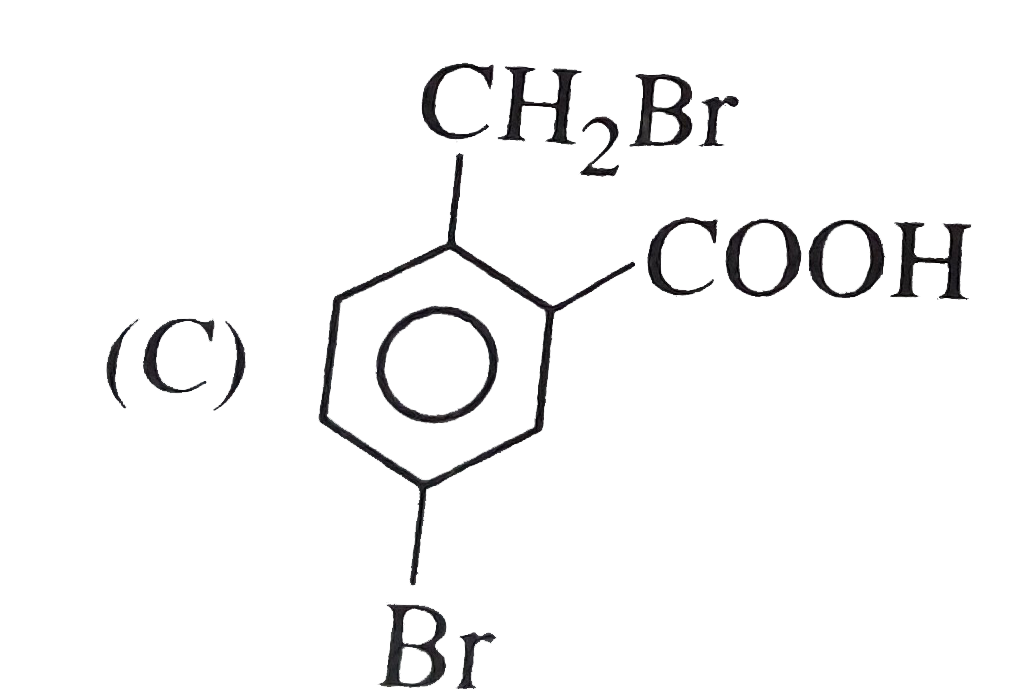Propanoic acid on warming with Br2 in presence of red P gives
CH3CH2COBr
CH3CH2Br
CH3CHBrCOOH
CH2BrCH2COOH
The correct Answer is:C
To solve the problem of what product is formed when propanoic acid is warmed with bromine in the presence of red phosphorus, we can follow these steps:
Step 1: Understand the Reactants
We start with propanoic acid, which has the structure:
CH3CH2COOH
Step 2: Reaction with Red Phosphorus and Bromine
When propanoic acid is treated with bromine (Br2) in the presence of red phosphorus, the red phosphorus reacts with bromine to form phosphorus tribromide (PBr3):
2P+3Br2→2PBr3
Step 3: Formation of Bromopropanoic Acid
The phosphorus tribromide then reacts with propanoic acid, replacing the hydroxyl group (-OH) with a bromine atom. This results in the formation of bromopropanoic acid:
CH3CH2COOH+PBr3→CH3CH2C(Br)O
Step 4: Tautomerization
The bromopropanoic acid can undergo tautomerization. In this process, the hydrogen atom adjacent to the carbonyl group can shift, leading to the formation of an enol form:
CH3CH2C(Br)=O⇌CH3CH2C(OH)=C(Br)
Step 5: Final Product Formation
The enol form can then react further, where the bromine can abstract a hydrogen atom, leading to the formation of a double bond and the final product, which is 3-bromopropenoic acid:
CH3CH=C(Br)COOH
Conclusion
The final product of the reaction of propanoic acid with bromine in the presence of red phosphorus is 3-bromopropenoic acid.
---
We start with propanoic acid, which has the structure:
CH3CH2COOH
When propanoic acid is treated with bromine (Br2) in the presence of red phosphorus, the red phosphorus reacts with bromine to form phosphorus tribromide (PBr3):
2P+3Br2→2PBr3
The phosphorus tribromide then reacts with propanoic acid, replacing the hydroxyl group (-OH) with a bromine atom. This results in the formation of bromopropanoic acid:
CH3CH2COOH+PBr3→CH3CH2C(Br)O
The bromopropanoic acid can undergo tautomerization. In this process, the hydrogen atom adjacent to the carbonyl group can shift, leading to the formation of an enol form:
CH3CH2C(Br)=O⇌CH3CH2C(OH)=C(Br)
The enol form can then react further, where the bromine can abstract a hydrogen atom, leading to the formation of a double bond and the final product, which is 3-bromopropenoic acid:
CH3CH=C(Br)COOH
The final product of the reaction of propanoic acid with bromine in the presence of red phosphorus is 3-bromopropenoic acid.
Topper's Solved these Questions
- BOOK - FIITJEECHAPTER - GENERAL ORGANIC CHEMISTRYEXERCISE - Section (II) [Jee mains]: With Single Correct Choice78videos
GENERAL ORGANIC CHEMISTRY
- BOOK - FIITJEECHAPTER - GENERAL ORGANIC CHEMISTRYEXERCISE - MORE THAN ONE CORRECT CHOICES24videos
GENERAL ORGANIC CHEMISTRY
- BOOK - FIITJEECHAPTER - GENERAL ORGANIC CHEMISTRYEXERCISE - SINGLE INTEGER ANSWER TYPE QUESTIONS14videos
GENERAL ORGANIC CHEMISTRY
- BOOK - FIITJEECHAPTER - GASEOUS STATEEXERCISE - MATCHING LIST TYPE QUESTION1videos
GASEOUS STATE
- BOOK - FIITJEECHAPTER - HYDROCARBONSEXERCISE - SINGLE INTEGER ANSWER TYPE QUESTION9videos
HYDROCARBONS
Similar Questions
Knowledge Check
- Question 1 - Select One
o−Toluic acid on reaction with Br2+Fe gives
A B
B C
C D
D
- Question 2 - Select One
Propionic acid on bromination in the presence of red phosphorus gives 2- bromo propionic acids it shows
Aoptical isomersBtautomerismCcis- trans isomersDmetamerism - Question 3 - Select One
o−toluic acid on reaction with Br2+Fe gives
A B
B C
C D
D
o−Toluic acid on reaction with Br2+Fe gives
View Solution2-Methyl butane on reacting with Br2 in the presence of sunlight mainly gives :
View Solution2-Methyl butane on reacting with Br2 in the presence of sunlight mainly gives :
View Solutiono-Toluic acid on reaction with Br2+Fe gives
View SolutionAcetic acid on warming with hydrazoic acid in presence of conc. H2SO4 gives
View Solution

